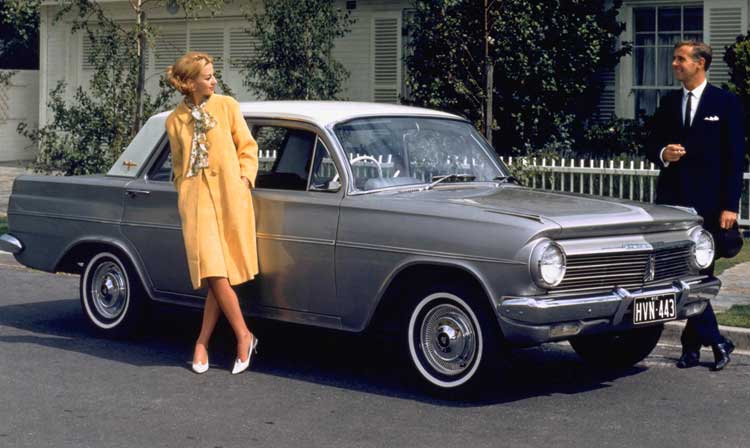Holden EH
The epitome of an Australian car, the Holden EH wasn't just stylish, it was bush-worthy, too

In an age when a new Cadillac can bear a quite remarkable resemblance to, and share quite a few components with, a Saab, its cousin in the great but troubled General Motors empire (and, indeed, can be made in Sweden rather than Detroit), it is refreshing to be reminded of the days when GM produced similar-sized cars across three continents that shared virtually no common parts.
In the early Sixties, for example, customers around the world were offered the Chevrolet Corvair, the Opel Kapitan, the Vauxhall PB Velox/Cresta and, mainly in Australia, the Holden EH. The first three are pretty much forgotten, but the Holden has the distinction of being truly classic.
Holden was originally an Adelaide-based coachbuilder, and, after its take-over in 1931 by GM, the firm served to assemble Vauxhalls, Bedfords and Chevrolets for the Australian market. Thus was the Australian industry born. Its first wholly manufactured car was the Chevrolet "FX" sedan of 1948, regarded as "Australia's Own Car".
The FX laid the foundation and dictated the formula for the marque's future success - a spacious cabin, excellent power-weight ratio, seating for six passengers, and a smooth- running six-cylinder engine that was allied to decent economy and a robust suspension system. Ideal for Antipodean conditions.
True, the FX also lacked indicators and side lamps, and its doors had the anti-social habit of bursting open while the car was in motion, but at a time when Australian correspondents to The Motor could complain of popular British "export or die" models falling to pieces on their rural roads, the Holden's success was understandable.
By the early Sixties, competition had intensified with the arrival of the slickly styled Ford Falcon and the rapid Chrysler Valiant, both of which were locally built. The EH, launched in August 1963, was Holden's response to these upstarts. It was seen then by many Holden enthusiasts as the ultimate example of the marque's virtues, and, to some, still epitomises the idea of an Australian car.
Over the next 18 months, General Motors-Holden (GMH) sold 256,959 EHs, making it the fastest-selling Australian car ever. Holden's publicity department modestly claimed that the EH was "the lowest-cost way to enjoy full-size, six-cylinder motoring", with "Holden's exciting new Power-Swept styling".
Indeed it was. The cheapest version of the EH offered many blue-collar Australians a chance to own a new six-cylinder car - especially as the EH was the same price as its predecessor, and actually cheaper than the Holdens of the mid-Fifties.
However, the official GMH brochures were careful not to convey any trace of cheapness, carrying picture after picture of Rod Taylor lookalikes in British-style blazers posing by a tastefully duo-toned EH Sedan. For such respectable Australians, those often parodied by Barry Humphries, the EH's Power-Swept styling was transatlantic without being excessive, and incorporated enough space for six adult passengers and 22 cubic feet for their luggage, all in a car that was under 15ft in length.
At a time when the Australian male would have felt naked without his hat, the EH's headroom was more than generous, its three- speed steering column gear change was very precise by early 1960s standards, the top speed from the standard 2.4-litre engine was an adequate 85mph, and there was even optional power steering. The only real gripes concerned the less welcome US legacy of the EH's very inefficient (unassisted) drum front brakes.
Best of all, the Holden had the fundamental advantage over its chief rivals - which included an Austin A60 Cambridge fitted with a locally built 2.4 six- cylinder engine known as the "Freeway 6" - in that it was, as already mentioned, "Australia's Own Car".
Holden may have been owned by GM, but the EH was conceived, designed and even exported as a recognisable Australian product. Within a year of its launch, it became one of the five major Australian icons of the 1960s (the other four being The Seekers).
The EH even had a fitted AM radio - such decadence was becoming necessary in the face of a new rival from Japan, the Nissan Cedric, which, as early as 1963, was already luring Sydney taxi drivers with its tinted glass and whitewall tyres.
After only 18 months of production, Holden, following the fashion of its US parent company, radically updated the EH, but the new HD came to be known as the "Horrible Design" or "Horrendous Disaster". For all of its mechanical and cabin improvements, the HD's styling (à la 1964 Vauxhall Victor FC) failed to catch the public eye, and in 2006 its values are a fraction of the EH.
Indeed, a well-restored Premier Sedan has been known to sell for A$20,000, and to a loyal Holden enthusiast, it is worth every cent. Nowadays, we even see some wonderfully able Holden coupés exported over here and rebadged as Vauxhall Monaros, but that future classic is a whole different story.
Subscribe to Independent Premium to bookmark this article
Want to bookmark your favourite articles and stories to read or reference later? Start your Independent Premium subscription today.

Join our commenting forum
Join thought-provoking conversations, follow other Independent readers and see their replies